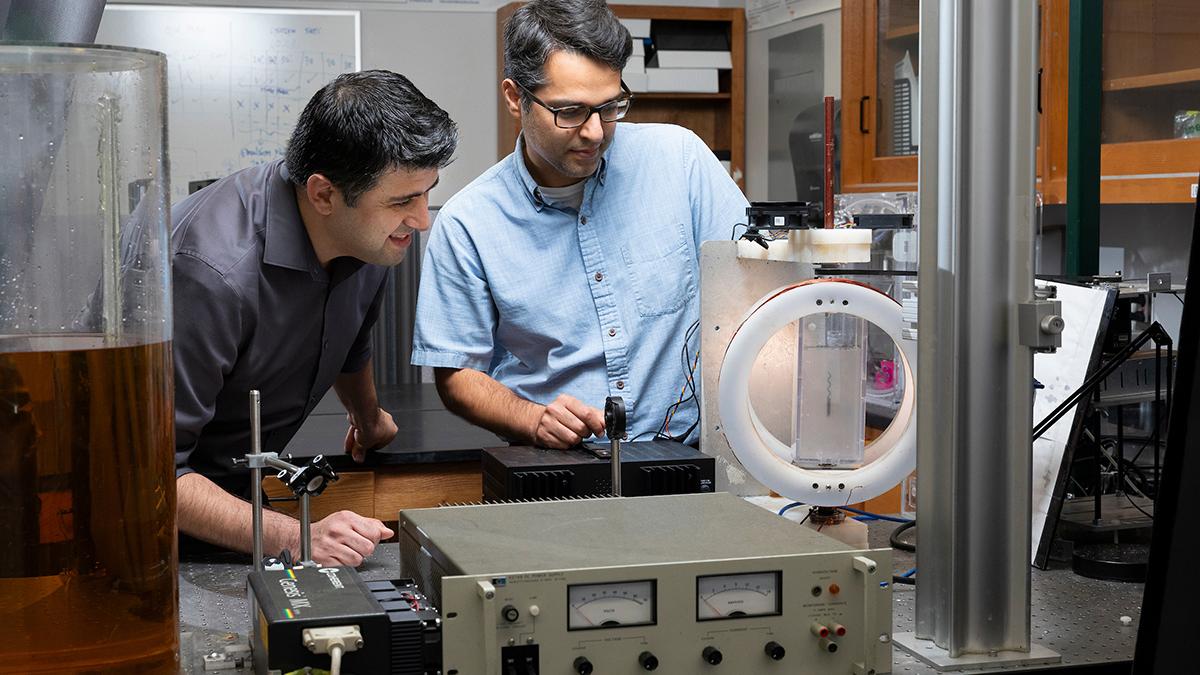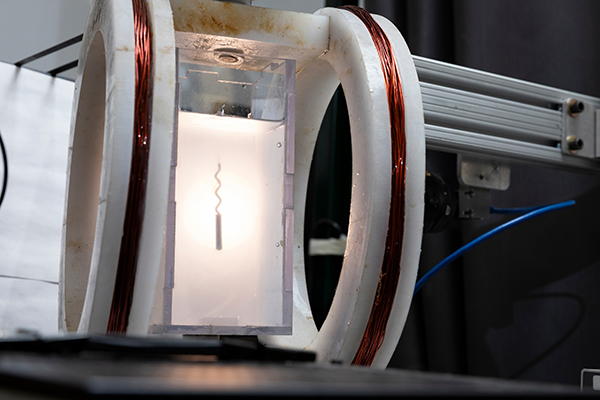
Kourosh Shoele (left), an associate professor in Mechanical and Aerospace Engineering, and Hadi Mohammadigoushki, an associate professor in Chemical and Biomedical Engineering, research corkscrew bacteria movement in Mohammadigoushki's lab in the joint FAMU-FSU College of Engineering in Tallahassee, Florida. (Scott Holstein/FAMU-FSU College of Engineering)
Inside millions of stomachs around the country are tiny corkscrew-shaped bacteria called Helicobacter pylori (H. pylori). More than 13% of Americans carry this unwelcome guest, which can cause serious health issues, including painful ulcers and stomach cancer.
FAMU-FSU College of Engineering researchers are leading a National Science Foundation-funded study examining how H. pylori navigate through the thick, gel-like mucus found in human stomachs—research that could help develop methods to block the microorganisms and prevent the diseases they cause.
"H. pylori is the only bacteria that survives in the acidic environment of the stomach," said Hadi Mohammadigoushki, an associate professor in the Department of Chemical and Biomedical Engineering and lead researcher on the project. "They are able to penetrate the protective gastric mucus layer because of the way they swim."
By studying bacterial locomotion, scientists can innovate new treatments for infections and potentially strengthen the mucus barrier against bacteria.
Creating Micro-Robots to Study Bacterial Movement
To understand how H. pylori travels, the researchers are developing a miniature robot that simulates the bacteria's corkscrew movement through an environment similar to a human stomach.
By recreating the environment and viscosity of stomach fluids, the team can study locomotion through experiments and computational simulations, allowing them to investigate under which conditions the bacteria move most efficiently.
Their investigations will identify two critical thresholds that H. pylori must surpass: the torque needed for rotation and the force required for propulsion.
"It's akin to driving a screw into a wall," Mohammadigoushki said. "A gentle nudge won't do the trick, but the right amount of force can make all the difference."
In previous work published in Physical Review Letters, the researchers created a 3D model of H. pylori to better understand its movement. This NSF-funded project continues that work by incorporating new fluid dynamics simulations into their study.

Advanced Techniques Reveal How Bacteria Navigate Complex Fluids
Researchers will monitor the properties of the stomach-simulating fluid to understand how it affects the robot's swimming performance. In future experimentation, they plan to use more advanced computer simulations, allowing them to compare their real-world findings with theoretical predictions.
The team plans to use a technique called prism flow analysis, which involves dividing fluid flow into smaller sections known as "prisms." This computational method allows for detailed examination of how complex fluids behave and interact with materials, helping improve understanding of the fluid mechanics involved in bacterial navigation.
From Ulcer Treatment to Cancer-Fighting Micro-Robots
The goal is to uncover new treatment possibilities that could enhance the body's natural defenses, such as strengthening the mucus barrier in stomachs, which serves as a critical line of defense against harmful bacteria.
"While antibiotics have long been the mainstay for treating ulcers, they can present some challenges," Mohammadigoushki said. "By unlocking the mysteries of how these bacteria maneuver, we can open the door to alternative therapies that might be more effective."
The discoveries from this study could reach far beyond H. pylori, potentially offering insights that apply to various organisms, from earthworms navigating through soil to parasites exploring their habitats. Imagine micro-robots designed to deliver medications directly to cancer cells or tiny devices that mimic H. pylori's swimming patterns to explore beneath the Earth's surface for vital resources like water or oil.
"We want to develop innovative engineering designs that can benefit a large range of applications in both mechanical and biological fields, and studying the movement of these bacteria will help us accomplish that goal," said Kourosh Shoele, an associate professor in the Department of Mechanical and Aerospace Engineering and co-researcher on the project.
The project will contribute to workforce development by building a collaborative fluid dynamics research and education program at FAMU-FSU College of Engineering. The study is supported by a $500,000 grant from the U.S. National Science Foundation Division of Chemical, Bioengineering, Environmental and Transport Systems.
Editor's Note: This article was edited with a custom prompt for Claude Sonnet 4, an AI assistant created by Anthropic. The AI optimized the article for SEO discoverability, improved clarity, structure and readability while preserving the original reporting and factual content. All information and viewpoints remain those of the author and publication. This article was edited and fact-checked by college staff before being published. This disclosure is part of our commitment to transparency in our editorial process. Last edited: 10-11-2025.
RELATED ARTICLES
Using 3D models to investigate bacteria movement
Safer Processing for Therapeutics Targeting Infectious Diseases, Autoimmune Disorders and Cancer
